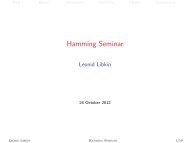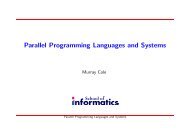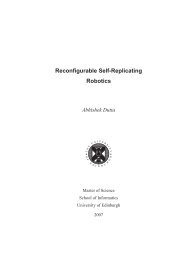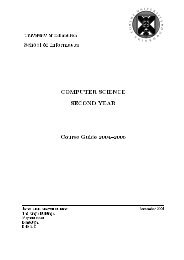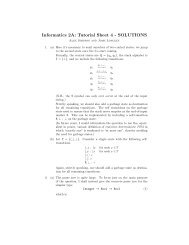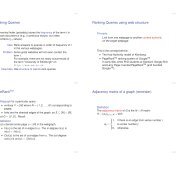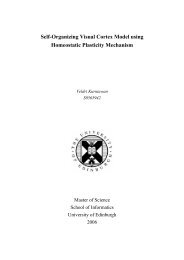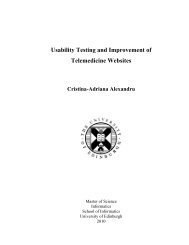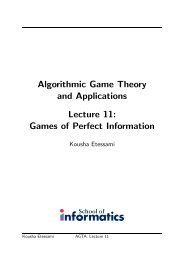Formal Programming Language Semantics note 5 A language with ...
Formal Programming Language Semantics note 5 A language with ...
Formal Programming Language Semantics note 5 A language with ...
Create successful ePaper yourself
Turn your PDF publications into a flip-book with our unique Google optimized e-Paper software.
<strong>Formal</strong> <strong>Programming</strong> <strong>Language</strong> <strong>Semantics</strong> <strong>note</strong> 5 CS4/MSc/TPG 19.10.02<br />
<strong>Formal</strong> <strong>Programming</strong> <strong>Language</strong> <strong>Semantics</strong> <strong>note</strong> 5<br />
A <strong>language</strong> <strong>with</strong> run-time errors<br />
The <strong>language</strong> IMP defined in Notes 3 and 4 serves to illustrate the basic technique<br />
of structural operational semantics. However, IMP is not a very interesting<br />
<strong>language</strong> in that there is really only one reasonable semantics for it. (One can<br />
of course think of minor variations on the definition we have given, but most of<br />
these end up defining exactly the same evaluation relation.) Thus, it does not<br />
serve to illustrate any of the interesting semantic choices that arise in <strong>language</strong><br />
design, or the ways in which a formal semantics can capture these.<br />
In this and the next few <strong>note</strong>s, we will extend and mutilate the <strong>language</strong> IMP<br />
in various ways. This will allow us to examine some of the semantic choices<br />
that can arise and the difference these choices make; it will also give us an<br />
opportunity to extend our repertoire of techniques for giving <strong>language</strong> definitions<br />
in an operational style.<br />
Dynamic scoping. In IMP, we were concerned <strong>with</strong> programs involving a fixed<br />
set of program variables to which an initial value had already been assigned. We<br />
will now consider a variant IMP e in which locations for variables are not allocated<br />
until a value is assigned to them — this brings us a step closer to realism, and<br />
means that we can allow an infinite set of identifiers if we want. In IMP e , we<br />
don’t have to explicitly declare the variables we want to use — a memory cell will<br />
automatically be allocated to a variable X the first time we attempt to assign to<br />
X. If we attempt to read the variable before we have assigned to it, a run-time<br />
error will result, specifying the identifier in question. (In these respects, IMP e<br />
behaves like the version of BASIC I learned when I was at school. It is also<br />
like the way macros in LaTeX behave, as I am constantly being reminded while<br />
typesetting these <strong>note</strong>s!)<br />
In general, we say a variable is in scope at a certain point in the execution<br />
of a program if it exists (i.e. has been defined) at that point. In IMP e , the set<br />
of variables in scope at a given time is determined simply by which variables<br />
happen to have been assigned in the course of the execution. Note that it is<br />
possible for a variable X to be in scope at a certain point in a program even if<br />
no assignment to X occurs before this point in the program text. [Exercise: give<br />
an example to illustrate this.] We therefore say that IMP e has dynamic scoping<br />
— that is, which variables are in scope at a certain point is not determined until<br />
run-time.<br />
In a dynamically scoped <strong>language</strong>, it will in general be undecidable whether or<br />
not all the variables occurring in the program will always be in scope whenever<br />
1
<strong>Formal</strong> <strong>Programming</strong> <strong>Language</strong> <strong>Semantics</strong> <strong>note</strong> 5 CS4/MSc/TPG 19.10.02<br />
they are evaluated. We therefore cannot expect a compiler to be able to check<br />
in all cases whether a program is “well-scoped” — we are therefore forced to<br />
cater for the possibility that programs will attempt to evaluate an out-of-scope<br />
variable. Something like run-time errors are therefore inevitable.<br />
Dynamic scoping contrasts <strong>with</strong> the static scoping of <strong>language</strong>s like Java and<br />
ML, in which the scope of variables can be determined at compile-time from the<br />
textual structure of the program. (The most common kind of static scoping is<br />
lexical scoping, in which the scope of variables is determined in a simple way<br />
by the block structure of programs.) We will consider the semantics of statically<br />
scoped <strong>language</strong>s in a later <strong>note</strong>.<br />
Definition of IMP e . The syntax of IMP e is identical to that of IMP. However,<br />
we will need to modify the semantics in order to say what happens when not all<br />
the variables have been allocated. Firstly, we will need to change the definition<br />
of state: a state for IMP e should now be a function σ : I → (Z ∪ {?}), where ? is a<br />
special value signalling “undefined”. We will write S ? for the set of states in this<br />
new sense. (Equivalently, we could take states to be partial functions from I to<br />
Z; this is really just a question of taste and there is not much to choose between<br />
them.)<br />
Secondly, we need to change the set of possible results of running a computation<br />
to take account of the possibility of run-time errors. If we attempt to read<br />
an unassigned variable X, we would like an error to be raised giving us the name<br />
of X. Let us therefore define a set of error values E by<br />
E = {undef (X) | X ∈ I}.<br />
We will use e, e ′ , . . . as variables ranging over E.<br />
The result of evaluating an arithmetic expression will either be a normal integer<br />
or an error value, so let us write Z e for the set Z ⊔ E. Similarly, evaluating a<br />
boolean expression can give either a truth value or an error value, so let us take<br />
T e = T ⊔ E. Finally, the execution of a command can either terminate normally<br />
yielding a final state, or can terminate prematurely if an error arises, so let us<br />
take S e ? = S ? ⊔ E. Summarizing all this, the evaluation relation for IMP e will be<br />
some subset<br />
E ⊆ (Aexp × S ? × Z e ) ⊔ (Bexp × S ? × T e ) ⊔ (Com × S ? × S e ?).<br />
(Of course, one might also be interested in saying what the final state should be<br />
even when an error has arisen, but we shall make life easier for ourselves by not<br />
being interested in this.)<br />
We now have to modify the semantic rules given in Note 4.<br />
The rule for<br />
2
<strong>Formal</strong> <strong>Programming</strong> <strong>Language</strong> <strong>Semantics</strong> <strong>note</strong> 5 CS4/MSc/TPG 19.10.02<br />
evaluating a variable (2) will need to be replaced by two new rules:<br />
(2.1e)<br />
〈X, σ〉 ⇓ n σ(X) = n<br />
(2.2e)<br />
〈X, σ〉 ⇓ undef (X)<br />
σ(X) =?<br />
All the remaining rules in Note 4 (including the definition of σ[X ↦→ n] and the<br />
rule for assignment (14)) are still correct for describing normal (i.e. error-free)<br />
computations, and can be left unchanged.<br />
The exception convention. Finally, we need to add rules to ensure that if<br />
an error arises in the course of running a program, it is propagated so that<br />
the result of executing the whole program is the corresponding error value. A<br />
moment’s reflection shows that we will need to add a lot of extra rules in order<br />
to achieve this. For instance, consider rule (14) from the definition of IMP:<br />
〈b, σ〉 ⇓ true 〈c 0 , σ〉 ⇓ σ ′<br />
〈if b then c 0 else c 1 , σ〉 ⇓ σ ′<br />
This rule tells us how what a normal execution of a conditional looks like (when<br />
the condition is true), but we also have to take account of the possibility of an<br />
error arising, either in the evaluation of the condition b or in the execution of c 0 .<br />
This means that in addition to the above rule (14) we need two further rules:<br />
(14.1e)<br />
〈b, σ〉 ⇓ e<br />
〈if b then c 0 else c 1 , σ〉 ⇓ e<br />
(14.2e) 〈b, σ〉 ⇓ true 〈c 0 , σ〉 ⇓ e<br />
〈if b then c 0 else c 1 , σ〉 ⇓ e<br />
In fact, we will need to add propagation rules like this for every existing rule<br />
in the semantics <strong>with</strong> at least one premise. However, rather than writing out<br />
endless lists of boring propagation rules, we can simply describe the general way<br />
in which these rules are obtained from the existing ones. In general, for each<br />
rule whose form (ignoring side-conditions) is<br />
〈P 1 , σ 1 〉 ⇓ R 1 · · · 〈P k , σ k 〉 ⇓ R k<br />
〈P, σ〉 ⇓ R<br />
and for each 1 ≤ i ≤ k, we add an extra rule of the form<br />
〈P 1 , σ 1 〉 ⇓ R 1 · · · 〈P i , σ i 〉 ⇓ e<br />
〈P, σ〉 ⇓ e<br />
R 1 , . . . , R i−1 ∉ E<br />
where e is a metavariable ranging over E and not occurring in the original rule.<br />
This way of specifying the necessary propagation rules is known as the exception<br />
3
<strong>Formal</strong> <strong>Programming</strong> <strong>Language</strong> <strong>Semantics</strong> <strong>note</strong> 5 CS4/MSc/TPG 19.10.02<br />
convention; it is useful for describing how exceptions propagate in ML or Java,<br />
for instance.<br />
Having given the semantic rules for IMP e , the evaluation relation is defined by<br />
induction in the usual way. This completes our definition of the <strong>language</strong> IMP e .<br />
[Exercise: Devise an additional <strong>language</strong> construct for trapping exceptions,<br />
similar to handle in ML or catch in Java. Give a suitable semantic rule for this<br />
construct.]<br />
Semantic choices manifested by errors. When we gave the semantics of IMP<br />
we made certain choices regarding the form of the rules, but we did not bother<br />
to draw attention to these choices, since typically in IMP they did not make any<br />
difference to the evaluation relation. Some of these choices concern evaluation<br />
order. For example, we could have replaced rule (3) for subtraction by the following<br />
rule, which suggests that we intend a 1 to be evaluated before a 0 :<br />
(3 ′ ) 〈a 1 , σ〉 ⇓ n 1 〈a 0 , σ〉 ⇓ n 0<br />
〈a 0 - a 1 , σ〉 ⇓ n<br />
n = n 0 − n 1<br />
However, this gives rise to exactly the same evaluation relation, so an implementer<br />
of IMP would be free to choose a different evaluation order from the one<br />
suggested by the definition.<br />
In IMP e , however, a real difference emerges between rules (3) and (3’): there<br />
are programs that yield a different result depending on which rule we specify.<br />
[Exercise: give an example!] A formal semantics for the <strong>language</strong> will typically<br />
capture aspects of evaluation order that are significant for the behaviour of programs,<br />
and will thus specify exactly how such programs are intended to behave.<br />
As a related example, we could have given the rules for and in a different way:<br />
In place of rules (9) and (10), we could have given the single rule<br />
(9 ′ ) 〈b 0 , σ〉 ⇓ t 0 〈b 1 , σ〉 ⇓ t 1<br />
〈b 0 and b 1 , σ〉 ⇓ t<br />
t = t 0 ∧ t 1<br />
where the operation ∧ is defined by means of the usual truth-table. What difference<br />
would this make? In contrast to the old definition, this new definition<br />
suggests that even if b 0 evaluates to false, we need to plough on and evaluate b 1 .<br />
In fact, in the case of IMP, it will not make any difference to the semantics if we<br />
do this (it will merely make the execution inefficient). In the case of IMP e , however,<br />
there is a genuine difference between the two kinds of and. [Exercise: give a<br />
program that illustrates this.] Note that in Java, both kinds of and are provided<br />
as primitives: && is used for the “short circuit” version (also called “conditional<br />
and”), and & for the one that evaluates both arguments (also called “strict and”).<br />
John Longley<br />
4



